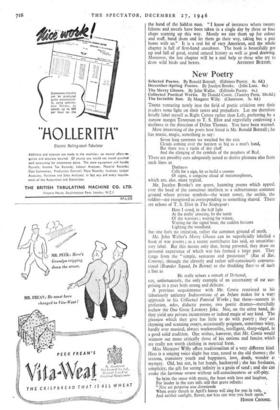ARTISTS that write about their work are rare , and it
is a fine per- formance of Mr. G. E. Lodge, at 85, to produce a book showing some of his best work and telling us how it was done. My pick of the illustrations, which cover many types of birds, are the sparrow- hawk, glaring as only a sparrowhawk can, at its eggs, and mallard, obviously frightened of slipping on wet ice: I have seen both these kinds of birds looking just like that. No artist in a lifetime can master more than a limited number of birds or beasts, and Mr. Lodge has not, I think, quite got either red deer or the owls, certainly not the short-eared, one of whose characteristics, as the many existing photographs show, is roundness of face. Mr. Lodge objects, he tells us, to an artist's paying too much attention to photographs, but they are sometimes a useful correction. I heartily agree with his opinion that Joseph Wolf was the greatest draughts- man of birds, and he, like Mr. Lodge, did much . of his work at the Zoo.
The book starts with a delightful chapter on hawking, a subject on which he is clearly an eitpert. It contains among other things a graphic description by an American in America of catching wild hawks on passage. A man is buried in the sand and holds a pigeon on a 9-foot cord to attract the hawk, which is eventually caught by the hand of the hidd:n man." " I know of instances where twenty falcons and tercels have been taken in a single day by three or four chaps teaming up this way. Mostly we size then' up for colour and stuff, band them and let them go their way, taking but a pair home with us." It is a real bit of racy American, and the whole chapter is full of first-hand anecdotes. The book is beautifully got up and full of good, sound natural history as well as good drawing. Moreover, the last chapter will be a real help to those who try to































 Previous page
Previous page